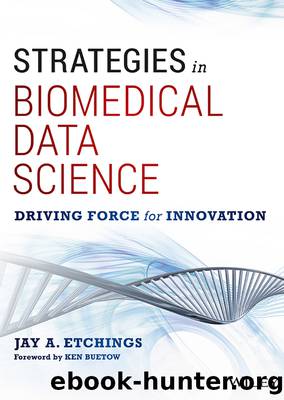Strategies in Biomedical Data Science by Buetow Ken;Etchings Jay A.;

Author:Buetow, Ken;Etchings, Jay A.; [Etchings, Jay]
Language: eng
Format: epub
ISBN: 9781119255970
Publisher: John Wiley & Sons, Incorporated
Published: 2016-12-08T16:00:00+00:00
Figure CS5.1 Ribbon Diagrams of Beta-lactamases
Ancestors of the protein TEM1, a protein whose function is to degrade penicillin, were resurrected and expressed and their structures were determinedâPNCA, GNCA, and ENCA. Despite having different functions, TEM1 (PDB: 1BTL, Red), ENCA (PDB: 3ZDJ, Orange), GNCA(PDB: 4B88, Green), and PNCA (PDB: 4C6Y, Blue) have similar sequences (53%â79% sequence similarity) and structures (0.53â0.84 Angstrom difference in RMSD) as compared to TEM1. Given the similarity in sequence and structure, their acquisition of divergent functions and evolution must occur through changes in the conformational dynamicsâthe accessible motion of internal rotational degrees of freedom.
Using GPU-accelerated molecular dynamics, we simulated the dynamics of each beta-lactamase. Our previous CPU runs [29] were run using the AMBER ff96SB force field [43], implicit solvation [44], and a special technique known as replica exchange molecular dynamics [45], an algorithm to gain a more accurate distribution of a given proteinâs conformational dynamics by running multiple simulations at different temperatures. Typically, a single CPU run on a 40-core supercomputer will take months (~250ps (metric horse power)/day) when trying to simulate up to 10 nano seconds (ns) per replica giving 400 ns aggregate simulation time. This is not including hitting the wall time, the maximum time allowed to run a job on a supercomputer, resubmitting a batch job, and waiting for the job to launch in the queue, which adds a considerable amount of time. On a GPU-accelerated machine we progress at about 50 ns/day, several orders of magnitude higher. The molecular dynamics simulations were performed using the AMBER 14 package, ff14SB force field [46], TIP3P solvation model [47], with a 2 femtosecond time step. After running molecular-dynamics simulations for 200 ns (~4 days), we divided the trajectory into eight equal windows of 25 ns. For each window we calculated the covariance matrix of atomic positions and the first eigenvector, which corresponds to the lowest frequency, first normal mode, or slowest global motion of the protein. The covariance matrix calculated from an MD simulation provides information on the sequence-encoded dynamics, as MD simulations take into account long-range interactions, solvation effects, and the biochemical specificity of amino acids. We then calculated the Pearson correlation between an eigenvector of a window and the eigenvector of the previous window. The window with the highest correlation is considered to be the most equilibrated. This covariance matrix of this window was used to calculate the DFI profile of a given variant.
DFI measures the flexibility of a particular position by finding how robust the position is to a perturbation. In a crowded cell environment, a protein is exposed to many different forces exerted by surrounding macromolecules and ligands. These forces are mimicked, to a first approximation, by applying small random forces on the protein and calculating the displacement of each residue. To calculate DFI, an external random force is sequentially applied on each residue. The perturbation cascades through the residue interaction network and may introduce conformational changes in the protein. The DFI of a particular position is the total displacement of that position induced by perturbations on all other residue of the protein.
Download
This site does not store any files on its server. We only index and link to content provided by other sites. Please contact the content providers to delete copyright contents if any and email us, we'll remove relevant links or contents immediately.
Human Diseases (MindTap Course List) (by Team-IRA) by Marianne Neighbors Ruth Tannehill-Jones(844)
The Neglected Dimension of Global Security: A Framework to Counter Infectious Disease Crises by National Academy of Medicine Secretariat(421)
Statistical Methods in Health Disparity Research by J. Sunil Rao(399)
Imaging in Urology by Mitchell Tublin MD Joel B Nelson MD(394)
Short Course in Medical Terminology by Nath Judi L.;(331)
Wilkins' Clinical Practice of the Dental Hygienist by Boyd Linda D.;Mallonee Lisa F.; & Lisa F. Mallonee(301)
Clinical Research in Occupational Therapy, Sixth Edition by Martin Rice;(300)
Cancer Cell Culture by Unknown(300)
Murray's Basic Medical Microbiology E-Book by Murray Patrick R.;(282)
Anatomical Kinesiology by Gross Michael;(281)
Psychedelics As Psychiatric Medications by Nutt David;Castle David;(272)
Neuroscience Fundamentals for Rehabilitation by Lundy-Ekman Laurie(269)
Health Behavior: Theory, Research, and Practice by Karen Glanz & Barbara K. Rimer & K. Viswanath(269)
Rang & Dale's Pharmacology 9th Edition plus Flashcards 2nd Edition by Unknown(250)
Public Health and Society: Current Issues by Burke Lillian D.;Weill Barbara;(246)
Achieving Procreation : Childlessness and IVF in Turkey by Merve Demircioğlu Göknar(246)
The Handbook of Medicinal Chemistry by Simon E Ward;Andrew Davis;(245)
Primary Care Occupational Therapy by Unknown(238)
From Good Schools to Great Schools by Susan P. Gray & William A. Streshly(232)
